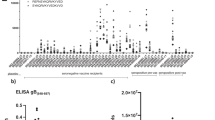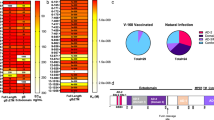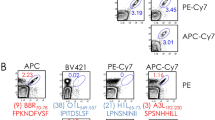Abstract
Although the smallpox virus was eradicated over 20 years ago, its potential release through bioterrorism has generated renewed interest in vaccination. To develop a modern smallpox vaccine, we have adapted vaccinia virus that was derived from the existing Dryvax vaccine for growth in a human diploid cell line. We characterized six cloned and one uncloned vaccine candidates. One clone, designated ACAM1000, was chosen for development based on its comparability to Dryvax when tested in mice, rabbits and monkeys for virulence and immunogenicity. By most measures, ACAM1000 was less virulent than Dryvax. We compared ACAM1000 and Dryvax in a randomized, double-blind human clinical study. The vaccines were equivalent in their ability to produce major cutaneous reactions ('takes') and to induce neutralizing antibody and cell-mediated immunity against vaccinia virus.
This is a preview of subscription content, access via your institution
Access options
Subscribe to this journal
Receive 12 print issues and online access
$209.00 per year
only $17.42 per issue
Buy this article
- Purchase on Springer Link
- Instant access to full article PDF
Prices may be subject to local taxes which are calculated during checkout




Similar content being viewed by others
References
Henderson, D.A. et al. Smallpox as a biological weapon: medical and public health management. J. Am. Med. Assoc. 281, 2127–2137 (1999).
Fenner, F., Henderson, D.A., Arita, I., Jezek, Z. & Ladnyi, I.D. Smallpox and its Eradication (World Health Organization, Geneva, 1988).
Henderson, D.A. & Moss, B. in Vaccines (eds. Plotkin, S.A. & Orenstein, W.A.) 74–97 (Saunders, Philadelphia, 1999).
LeDuc, J.W. & Becher, J. Current status of smallpox vaccine. Emerg. Infect. Dis. 5, 593–594 (1999).
Nagao, S., Inaba, S. & Iijima, S. Langerhans cells at the sites of vaccinia virus inoculation. Arch. Dermatol. Res. 256, 23–31 (1976).
Cole, G. & Blanden, R. in Comprehensive Immunology Vol. 9 Immunology of Human Infection Part II Viruses and Parasites (eds. Nahmias, A.J. & O'Reilly, R.J.) 1–19 (Plenum, New York, 1982).
Frey, S.E. et al. Dose-related effects of smallpox vaccine. N. Engl. J. Med. 346, 1275–1280 (2002).
Frey, S.E. et al. Clinical responses to undiluted and diluted smallpox vaccine. N. Engl. J. Med. 346, 1265–1274 (2002).
Marennikova, S.S., Chimishkyan, K.L., Maltseva, N.N., Shelukhina, E.M. & Fedorov, V.V. in Proceedings of the Symposium on Smallpox, 2 & 3 September 1969 (ed. Gusic, B.) 65–79 (Yugoslav Academy of Sciences and Arts, Zagreb, 1969).
Marennikova, S.S. in International Symposium on Smallpox Vaccine, Bilthoven, the Netherlands, 11–13 October 1972 Vol. 19 253–260 (Karger, Basel, 1973).
Morita, M., Arita, M., Komatsu, T., Amano, H. & Hashizume, S. A comparison of neurovirulence of vaccinia virus by intrathalamic and/or intracisternal inoculations into cynomolgus monkeys. Microbiol. Immunol. 21, 417–418 (1977).
Williamson, J.D., Reith, R.W., Jeffrey, L.J., Arrand, J.R. & Mackett, M. Biological characterization of recombinant vaccinia viruses in mice infected by the respiratory route. J. Gen. Virol. 71, 2761–2767 (1990).
Bray, M. et al. Cidofovir protects mice against lethal aerosol or intranasal cowpox virus challenge. J. Infect. Dis. 181, 10–19 (2000).
Martinez, M.J., Bray, M.P. & Huggins, J.W. A mouse model of aerosol-transmitted orthopoxviral disease: morphology of experimental aerosol-transmitted orthopoxviral disease in a cowpox virus-BALB/c mouse system. Arch. Pathol. Lab. Med. 124, 362–377 (2000).
Fine, H.L. Keloids containing hair and sebaceous glands. Arch. Dermatol. 96, 185–187 (1967).
Centers for Disease Control. Cardiac events following smallpox vaccination—United States, 2003. MMWR Morb. Mortal. Wkly. Rep. 52, 248–250 (2003).
Kutinova, L. et al. Search for optimal parent for recombinant vaccinia virus vaccines. Study of three vaccinia virus vaccinal strains and several virus lines derived from them. Vaccine 13, 487–493 (1995).
Kutinova, L. et al. Influence of the parental virus strain on the virulence and immunogenicity of recombinant vaccinia viruses expressing HBV preS2-S protein or VZV glycoprotein I. Vaccine 14, 1045–1052 (1996).
Ehrengut, W., Sarateanu, D.E., Alswede, U., Habib, A. & Tetzlaff, G. Vaccinia virus variants as presumable cause of vaccinial complications. Arch. Virol. 48, 229–238 (1975).
Vilesova, I.S., Gurvich, E.B., Dzagurov, S.G., Grigor'eva, L.V. & Abel, H. Changes in the properties of the vaccinia virus isolated in postvaccinal encephalitis. Vopr. Virusol. 30, 477–482 (1985).
McIntosh, K. et al. Clinical and serologic study of four smallpox vaccines comparing variations of dose and route of administration. Standard percutaneous revaccination of children who receive primary percutaneous vaccination. J. Infect. Dis. 135, 155–166 (1977).
Reed, L. & Muench, H. Simple method of determining fifty percent endpoints. Amer. J. Hyg. 27, 493–497 (1938).
Smith, G.L., Vanderplasschen, A. & Law, M. The formation and function of extracellular enveloped vaccinia virus. J. Gen. Virol. 83, 2915–2931 (2002).
Ennis, F.A., Cruz, J., Demkowicz, W.E., Rothman, A.L. & McClain, D.J. Primary induction of human CD8+ cytotoxic T lymphocytes and interferon-γ-producing T cells after smallpox vaccination. J. Infect. Dis. 185, 1657–1659 (2002).
Pross, H.F., Baines, M.G., Rubin, P., Shragge, P. & Patterson, M.S. Spontaneous human lymphocyte-mediated cytotoxicity against tumor target cells. IX. The quantitation of natural killer cell activity. J. Clin. Immunol. 1, 51–63 (1981).
Acknowledgements
We thank G. Drabik, T. Farrell, K. Georgakopoulos, J. Hamberger, Y. Liu, P. Papastathis and S. Pougatcheva (Acambis) for expert technical assistance; N. Tobin and E. Gove (Acambis) for animal care; D. Vellom (Acambis) for purification method development; T. Kemp and S. Woodward (Acambis) and D. Mathis (PRA International) for clinical trial assistance; W. T. Archambault (Virtu Stat) for statistical advice; R. McAvoy (Acambis) for contract management; I. Levenbook for neuropathological evaluation of monkey tissues; and J. Gilly and P. Lyons (BioReliance) for vaccine manufacturing and testing. We also thank J. Becher, J. W. LeDuc, J. Esposito and L. Falgiano (CDC) and P. K. Russell and D.A. Henderson (US Department of Health and Human Services) for advice and support. This work was supported by contract number 200-2000-00001 from the CDC. The content of this publication does not necessarily reflect the views or policies of the Department of Health and Human Services, nor does mention of trade names, commercial products or organizations imply endorsement by the United States Government.
Author information
Authors and Affiliations
Corresponding authors
Ethics declarations
Competing interests
R.W., J.L., K.V.P., G.A.M., B.C., P.S.B., R.N. & T.M. are employees of Acambis Inc., which manufactures the ACAM1000 vaccine, and as such own stock or have been granted stock options in Acambis Inc.
Rights and permissions
About this article
Cite this article
Weltzin, R., Liu, J., Pugachev, K. et al. Clonal vaccinia virus grown in cell culture as a new smallpox vaccine. Nat Med 9, 1125–1130 (2003). https://doi.org/10.1038/nm916
Received:
Accepted:
Published:
Issue Date:
DOI: https://doi.org/10.1038/nm916
This article is cited by
-
First-in-human study of TK-positive oncolytic vaccinia virus delivered by adipose stromal vascular fraction cells
Journal of Translational Medicine (2019)
-
HLA alleles associated with the adaptive immune response to smallpox vaccine: a replication study
Human Genetics (2014)
-
Genomic sequence and analysis of a vaccinia virus isolate from a patient with a smallpox vaccine-related complication
Virology Journal (2006)
-
The Future of Smallpox Vaccination: is MVA the key?
Medical Immunology (2005)



